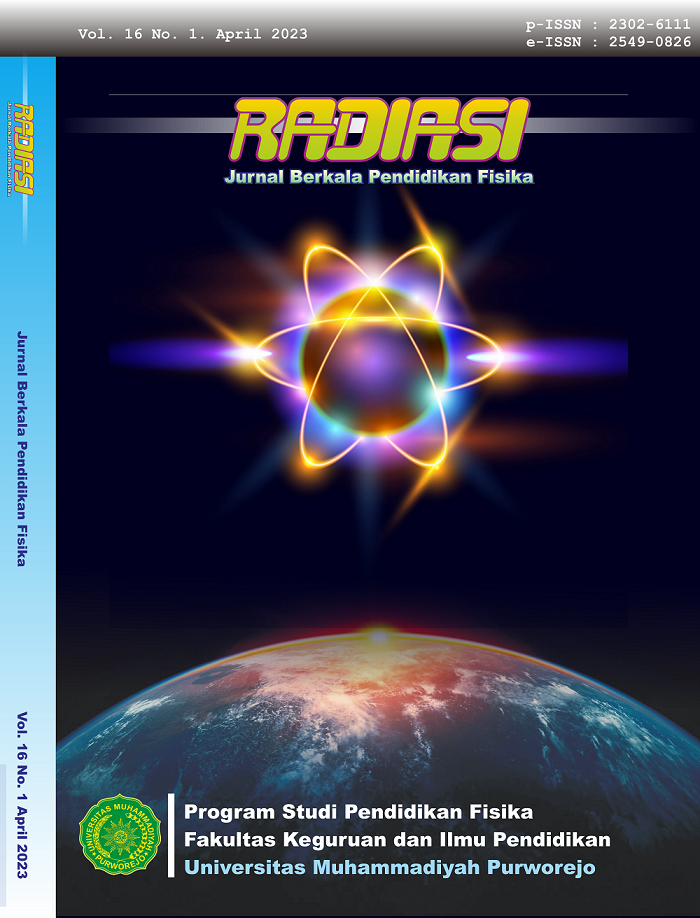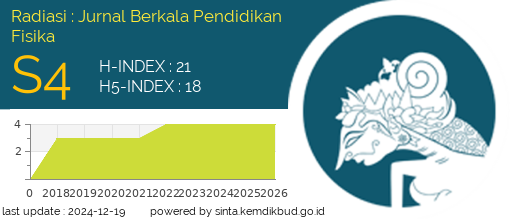Development of a Recitation Program with Feedback and Reinforcement Questions to Improving Students' Concept
Abstract
This study aims to develop and determine the feasibility of learning media consisting of a recitation program with feedback and reinforcement questions to improve students' mastery of concepts. The research design used ADDIE which consisted of 5 research stages, namely: 1) Analysis, 2) Design, 3) Development, and 4) Implementation. Based on data analysis, the media validity average value was 3.7. Thus, it can be concluded that the recitation program with feedback and reinforcement questions has a very valid (worthy) category. Based on the results of this research, the development of a recitation program with feedback and reinforcement questions can be used in learning to improving students' Physics concept.
Downloads
References
D. E. Saputri, M. R. A. Taqwa, F. N. Aini, M. I. Shodiqin, dan L. Rivaldo, “Pemahaman Konsep Mekanika: Menentukan Arah Percepatan Pendulum, Sulitkah?,” J. Pendidik. Fis. Dan Teknol., vol. 5, no. 1, hlm. 110–117, 2019, doi: 10.29303/jpft.v5i1.1134.
J. L. Docktor dan J. P. Mestre, “Synthesis of Discipline-Based Education Research in Physics,” Phys. Rev. Spec. Top. - Phys. Educ. Res., vol. 10, no. 2, hlm. 1–58, 2014, doi: 10.1103/PhysRevSTPER.10.020119.
B. Hegde, “How do they solve it ? An insight into the learner ’ s approach to the mechanism of physics problem solving,” vol. 010109, hlm. 1–9, 2012, doi: 10.1103/PhysRevSTPER.8.010109.
M. R. A. Taqwa dan H. F. Rahim, “Students’ conceptual understanding on vector topic in visual and mathematical representation: a comparative study,” J. Phys. Conf. Ser., no. 2309, hlm. 1–6, 2022, doi: 10.1088/1742-6596/2309/1/012060.
M. R. A. Taqwa dan R. Faizah, “Perlunya Program Resitasi dalam Meningkatkan Penguasaan Konsep Dinamika Partikel Mahasiswa,” Semin. Nas. Pembelajaran Ipa Ke-1, no. May, hlm. 482–487, 2016.
S. Rahmawati, S. Kusairi, dan Sutopo, “Analisis Penguasaan Konsep Siswa Yang Belajar Materi Momentum dan Impuls Berbasis Scientific Approach Disertai Formative Assessment Berbantuan WEB,” J. Pembelajaran Sains, vol. 3, no. 1, hlm. 1–6, 2019.
I. Agustina, D. Astuti, R. A. Sumarni, dan D. L. Saraswati, “Pengembangan Media Pembelajaran Fisika Mobile Learning berbasis Android,” J. Penelit. Pengemb. Pendidik. Fis., vol. 3, no. 1, hlm. 57–62, 2017.
M. Reyza, A. Taqwa, dan A. Hidayat, “Deskripsi Penggunaan Program Resitasi dalam Meningkatkan Kemampuan Membangun Free-Body Diagrams ( FBDs ),” J. Pendidik. Fis. Tadulako Online, vol. 5, no. 1, hlm. 52–58, 2017.
Z. Azizah, M. R. A. Taqwa, dan I. T. Assalam, “Analisis Pemahaman Konsep Fisika Peserta Didik Menggunakan Instrumen Berbantuan Quizizz,” J. Pendidik. Sains Mat., vol. 8, no. 2, hlm. 1–11, 2020.
N. S. Podolefsky dan N. D. Finkelstein, “Use of analogy in learning physics : The role of representations,” Phys. Rev. Spec. Top. - Phys. Educ. Res., vol. 2, no. 2, hlm. 1–10, 2006, doi: 10.1103/PhysRevSTPER.2.020101.
D. Rosengrant, A. Van Heuvelen, dan E. Etkina, “Do students use and understand free-body diagrams ?,” vol. 5, no. 1, hlm. 1–13, 2009, doi: 10.1103/PhysRevSTPER.5.010108.
M. R. A. Taqwa dan L. Rivaldo, “Kinematics Conceptual Understanding : Interpretation of Position Equations as A Function of Time,” J. Pendidik. Sains, vol. 6, no. 4, hlm. 120–127, 2018, doi: http://dx.doi.org/10.17977/jps.v6i4.11274.
E. Etkina dkk., “Scientific abilities and their assessment,” hlm. 1–15, 2006, doi: 10.1103/PhysRevSTPER.2.020103.
D. Nguyen dan N. S. Rebello, “Students ’ understanding and application of the area under the curve concept in physics problems,” vol. 010112, no. January, hlm. 1–17, 2011, doi: 10.1103/PhysRevSTPER.7.010112.
M. De Cock, “Representation use and strategy choice in physics problem solving,” Phys. Rev. Spec. Top. - Phys. Educ. Res., vol. 8, no. 2, hlm. 1–15, 2012, doi: 10.1103/PhysRevSTPER.8.020117.
D. Hestenes dan D. Hestenes, “Modeling Methodology for Physics Teachers,” vol. 935, 1997, doi: 10.1063/1.53196.
A. Van Heuvelen dan X. Zou, “Multiple Representations of Work–Energy Processes,” Am. Assoc. Phys. Teach., vol. 69, no. 2, hlm. 184–194, 2001, doi: 10.1119/1.1286662.
P. B. Kohl dan N. D. Finkelstein, “Student representational competence and self-assessment when solving physics problems,” no. May, hlm. 1–11, 2005, doi: 10.1103/PhysRevSTPER.1.010104.
D. E. Meltzer, “Relation between students ’ problem-solving performance and representational format Relation between students ’ problem-solving performance and representational format,” Am. Assoc. Phys. Teach., vol. 73, no. 5, hlm. 463–478, 2005, doi: 10.1119/1.1862636.
P. B. Kohl, D. Rosengrant, dan N. D. Finkelstein, “Strongly and weakly directed approaches to teaching multiple representation use in physics,” hlm. 1–10, 2007, doi: 10.1103/PhysRevSTPER.3.010108.
T. A. Romansyah dan M. R. A. Taqwa, “Konsistensi Representasi dalam Menyelesaikan Kasus Jarak Tempuh,” Radiasi J. Berk. Pendidik. Fis., vol. 14, no. 2, hlm. 87–98, 2021, doi: 10.37729/radiasi.v14i2.1143.
M. R. A. Taqwa, A. Amalina, dan A. Suyudi, “Impact of computer assisted resitation program on students ’ conceptual undestanding on static fluid topics Impact of computer assisted resitation program on students ’ conceptual undestanding on static fluid topics,” J. Phys. Conf. Ser., no. 2309, hlm. 1–7, 2022, doi: 10.1088/1742-6596/2309/1/012042.
R. Arends, Learning to Teach, Ninth Edit. 1221 Avenue of the Americas, New York: McGraw-Hill, 2012.
T. N. Diyana, Sutopo, dan Sunaryono, “The effectiveness of web-based recitation program on improving students’ conceptual understanding in fluid mechanics,” J. Pendidik. IPA Indones., vol. 9, no. 2, hlm. 219–230, 2020, doi: 10.15294/jpii.v9i2.24043.
K. M. Koenig, R. J. Endorf, dan G. A. Braun, “Effectiveness of different tutorial recitation teaching methods and its implications for TA training,” hlm. 1–9, 2007, doi: 10.1103/PhysRevSTPER.3.010104.
I. Sandoval dan E. Possani, “An analysis of different representations for vectors and planes in ℝ3: Learning challenges,” Educ. Stud. Math., vol. 92, no. 1, hlm. 109–127, 2016, doi: 10.1007/s10649-015-9675-2.
L. Bollen, P. Van Kampen, C. Baily, M. Kelly, dan M. De Cock, “Student difficulties regarding symbolic and graphical representations of vector fields,” Phys. Rev. Phys. Educ. Res., vol. 13, no. 2, hlm. 1–17, 2017, doi: 10.1103/PhysRevPhysEducRes.13.020109.
M. C. Dianningrum, Sutopo, dan A. Hidayat, “Students ’ understanding of circular motion with multi representational approach,” dalam International Conference on Science and Apllied Science (ISCAS2020), 2020.
S. S. Silaen, D. N. Sudjito, dan M. Sudarmi, “Pengembangan Tes Diagnostik Multi Representasi Eksternal (MRE) untuk Mengetahui Profil Kemampuan Representasi Konsep,” Publ. Pendidik., vol. 9, no. 2, hlm. 98, 2019, doi: 10.26858/publikan.v9i2.8477.
B. Waldrip, V. Prain, dan J. Carolan, “Learning Junior Secondary Science through Multi-Modal Representations,” vol. 11, no. 1, 2006.
P. Nieminen, A. Savinainen, dan J. Viiri, “Force concept inventory-based multiple-choice test for investigating students’ representational consistency,” Phys. Rev. Spec. Top. - Phys. Educ. Res., vol. 6, no. 2, hlm. 1–12, 2010, doi: 10.1103/PhysRevSTPER.6.020109.
Copyright (c) 2023 Handy Faishal Rahim, Arif Hidayat, Sutopo Sutopo

This work is licensed under a Creative Commons Attribution-NonCommercial 4.0 International License.




